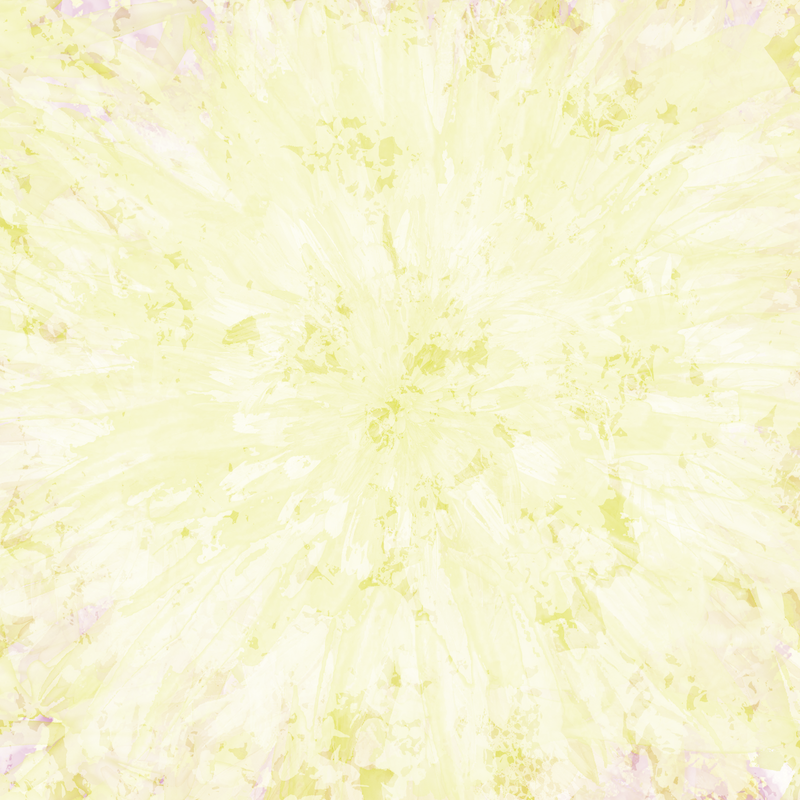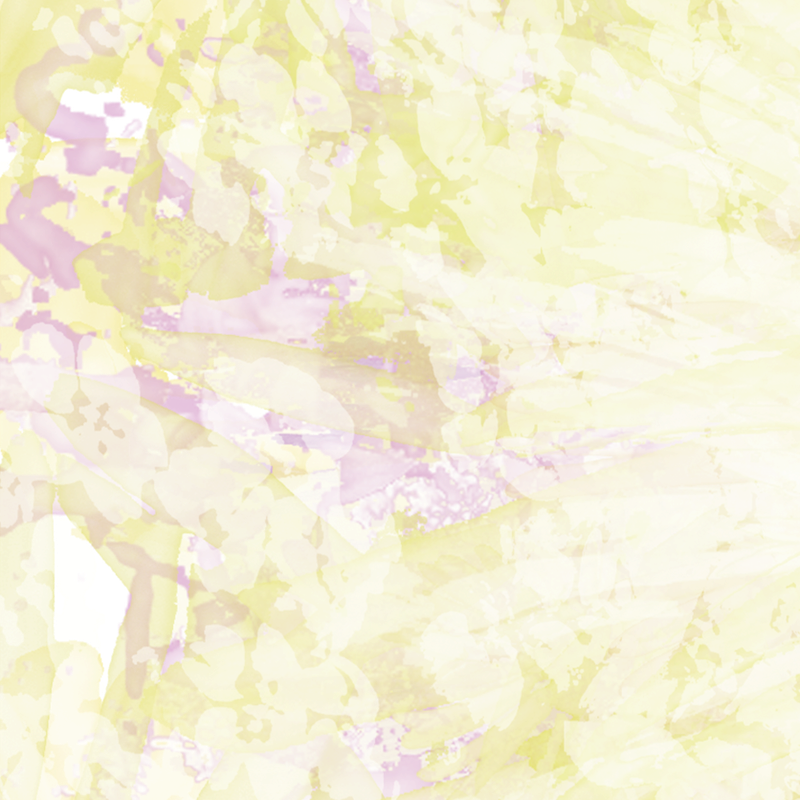
Asteraceae, Biodynamics, Soundscapes

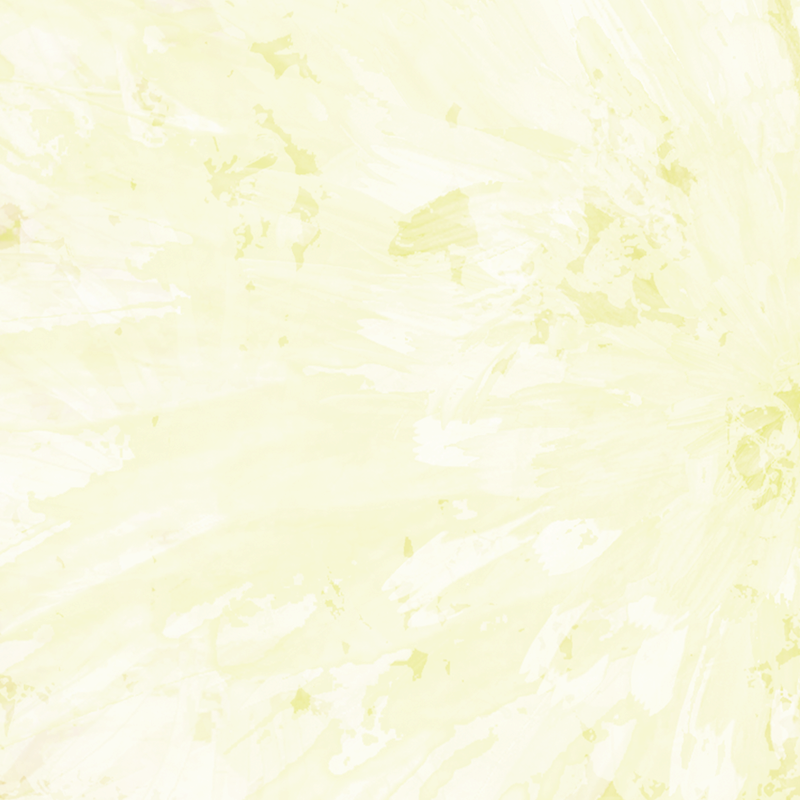
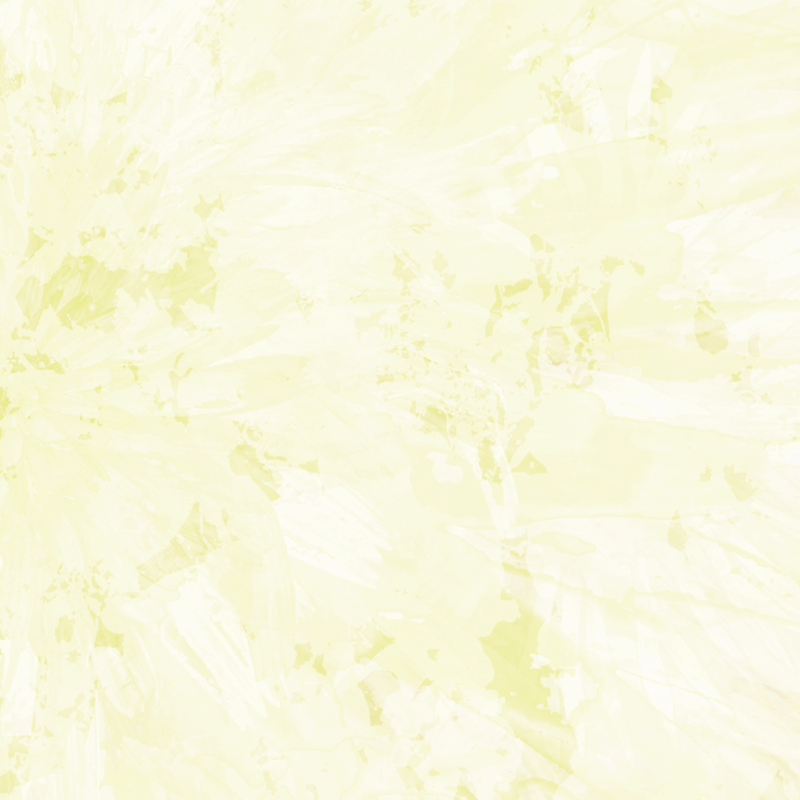
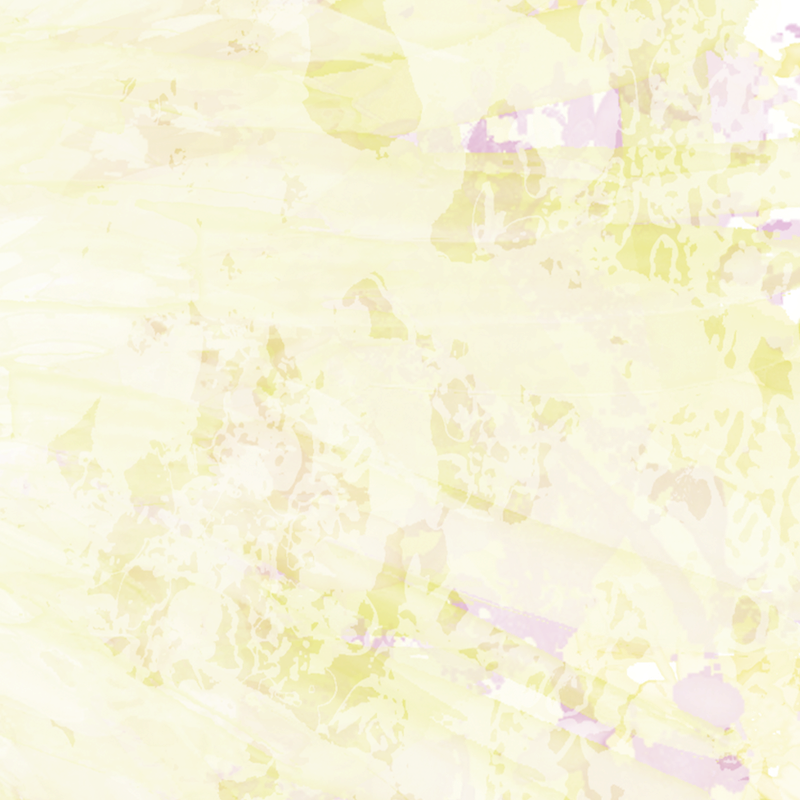
Achillea. (20-VI-2020). Compositae. JFMAMJJASOND, JMF100.
Tracklist [144:00]
- Yarrow; Achillea L.; Anthemideae Cass. [12:00]
- Wolf’s bane; Arnica L.; Heliantheae Cass. [12:00]
- Carline thistle; Carlina L.; Cynareae Lam. & DC. [12:00]
- Knapweed; Centaurea L.; Cynareae Lam. & DC. [12:00]
- Thistle; Cirsium Mill.; Cynareae Lam. & DC. [12:00]
- Leopard’s bane; Doronicum L.; Senecioneae Cass. [12:00]
- Hawkweed; Hieracium L.; Cichorieae Lam. & DC. [12:00]
- Hawkbit; Leontodon L.; Cichorieae Lam. & DC. [12:00]
- Daisy; Leucanthemum Mill.; Anthemideae Cass. [12:00]
- Butterbur; Petasites Mill.; Senecioneae Cass. [12:00]
- Salsify; Scorzonera L.; Cichorieae Lam. & DC. [12:00]
- Ragwort; Senecio L.; Senecioneae Cass. [12:00]
Introduction
Compositae (Asteraceae from Latin aster, "star”) is a cosmopolitan family of dicotyledonous flowering plants named after the inflorescence known as a pseudanthium (from Greek “false flower”) or composite flower. Composite flowers are false flowers composed of multiple true flowers or florets, clusters of disk or ray flowers (Funk et al. 2009). Compositae is a composition comprised of composite presentations of multiple recordings, clusters of discs or tracks. Composite presentations treat soundscapes with amplification, filtration, compression, and reproduction to synergize beautification.Composite flowers heal humans, remedying symptoms of underlying diseases such as excitation, depression, desiccation, and stagnation. Symptoms are respectively treated with acrid nausents or sour flavonoids, pungent essential oils, sweet polysaccharides, and astringent tannins or bitter tonics that balance polarities with sedation, stimulation, circulation, and digestion (Grieve 1971a, 1971b; Hauschka 1988; Ody 1993; Husemann 1994; Kolisko & Kolisko 1996; Steiner 1997; Hoffmann 2003; Weed 2003; Culpeper 2008; Wood 2008 & 2009; Baker 2010; Gladstar 2012; Pelikan 2016a, 2016b).
Composite flowers cure farms, remedying symptoms and treating underlying diseases identical to herbal medicines for humans (Steiner 1958; Plank 1976; Bockemühl 1980; Philbrick & Philbrick 1988; Koepf 1989; Koepf 2012; Thun 1999; Osthaus 2010; Pfeiffer 2011a, 2011b; Klocek 2013; Masson 2014). Compositae are applied to farmscapes with cover crops, hedgerows, meadows, and other conservation features (Philbrick & Gregg 1991; Altieri et al. 2005; Gurr et al. 2012; Xerces Society 2014; Lee-Mäder et al. 2015; Fowler et al. 2016; Fowler 2017; Fowler & Droege 2020).
Plants are one with life, tone, and water; flowers are one with spirit, sound, and air (Goethe & Steiner 1978; Steiner 1979; Goethe 1993; Schwenk 1996; Lauterwasser 2007; Suchantke 2009; Wilkes 2009; Fowler et al. 2011; Holdredge 2013; Laruelle 2013; Fowler 2014; Steiner 2015). Could sonic composites treat soundscapes, remedying coldness with amplification, dampness with filtration, tenseness with compression, and dryness with reproduction? Can Compositae cultivate and propagate soundscape features that conserve and enhance soundscape health?
Description
Composer Michael Pisaro-Liu recorded in the Große Mühl (“Great Mill” or “Michel”) River region of Upper Austria during 2011–2015 as part of The Flussaufwärtstreiben Installation (Pisaro 2019). Flussaufwärtstreiben ("floating upstream") was hosted by Joachim Eckl at The Station in Neufelden. The installation was composed of recordings of daily two-hour walks along the Große Mühl to six locations, where 12-minute activities were observed in shelters designed and constructed by artist Marcus Kaiser.
Shelter activities included listening, recording, broadcasting, and performing. Broadcasts encompassed field recordings, sine tones, and filtered noises. Field recordings included sounds of water, air, plants, animals, and humans observed from the shelters. Performances incorporated selections of compositions “auch da” (Beuger 2007) and “sleeping scales” (Pisaro 2007). Performers were composers-musicians from the international Wandelweiser Group:
- Antoine Beuger (Flute)
- Jürg Frey (Clarinet)
- Marcus Kaiser (Cello)
- Radu Malfatti (Trombone)
- André Möller (Guitar)
- Kathryn Gleasman Pisaro (Oboe)
Nature Denatured and Found Again (NDaFA, Pisaro 2019) presented five 48-minute compact discs, four 12-minute tracks per disc (240 minutes and 20 tracks overall) composed from recordings made during The Flussaufwärtstreiben Installation. Recordings included filtered and unfiltered field recordings of musical and non-musical sounds, sine tones and filtered noises, and documentation of a concert performed in 2012 at The Station. Documentation presented amplified features of interactions in the Große Mühl region.
Liner notes by Pisaro (2019) described a second installation of recordings from Flussaufwärtstreiben during 2017 at The Station. Pisaro proposes that NDaFA tracks can be arranged in combinations and simultaneously broadcasted for future installations. If composite recordings of NDaFA tracks were created, then would NDaFA be conserved and enhanced for soundscape health? Predictions foreshowed that composites will conserve local conditions, while enhancing soundscape health: medication, sanitation, regeneration, recuperation, and beautification.
Methods
All 20 audio tracks from Pisaro 2019 were imported (Stereo, 44100 Hz, 32-bit float), analyzed, edited, and effected with Audacity 2.1.0. Frequency analysis was conducted and four three-minute selections per track were plotted (Algorithm: Spectrum, Function: Hanning window, Size: 4096, Axis: Linear frequency; 80 plots). Plotted spectrum peaks were noted with TextEdit 1.10 and rounded to the nearest tenth, hundredth, or thousandth Hertz.Each track was duplicated, creating 20 pairs of 40 tracks. Each duplicate pair was equalized with subtractive drawn curves, whose peaks were correlated with track-specific frequency analyses. Equalization was syncopated amongst duplicate pairs. Equalization (length of filter = ~4000) was filtered between 20 Hz to 20000 Hz from 0 dB to -30 dB at ten descending three decibel intervals followed by 11 to 34 filters from -27 dB to -30 dB according to track-specific peak frequencies.
All analyzed and equalized duplicates (40 tracks) were effected four times with random amplitude modulation (Max amplitude sweep speed = 0.40 Hz, Amplitude sweep depth factor = 40 factor). All equalized and modulated duplicates were selected and amplified per disc (N = five discs) to new peak amplitude = -12.0 dB, effecting eight new peak amplitudes per disc.
All equalized, modulated, and amplified duplicates per disc (N = five discs) were panned at intervals to enhance yet preserve native stereo distributions. Pan at 90% intervals, tracks 01-05:
Pan at 100% intervals, tracks 06-09:
- N.1x = 90% Left
- N.1y = Center
- N.2x = 60% Left
- N.2y = 30% Right
- N.3x = 30% Left
- N.3y = 60% Right
- N.4x = Center
- N.4y = 90% Right
- 1.Nx = 90% Left
- 1.Ny = 10% Right
- 2.Nx = 70% Left
- 2.Ny = 30% Right
- 3.Nx = 50% Left
- 3.Ny = 50% Right
- 4.Nx = 30% Left
- 4.Ny = 70% Right
- 5.Nx = 10% Left
- 5.Ny = 90% Right
Analyzed, edited, and effected duplicates were paired (N.Nx + N.Ny = N.N) and ten audio files were exported (.WAV, 32 bit PCM) to two stereo channels as follows:
*Track 10 = Composite of new tracks 01 (Pan = 60% Left), 02 (Pan = 30% Left), 03 (Pan = Center), 04 (Pan = 30% Right), and 05 (Pan = 60% Right).
10* 06 07 08 09 01 1.1 1.2 1.3 1.4 02 2.1 2.2 2.3 2.4 03 3.1 3.2 3.3 3.4 04 4.1 4.2 4.3 4.4 05 5.1 5.2 5.3 5.4 Thus, the following ten composite tracks were exported:
- 1.1, 1.2, 1.3, 1.4
- 2.1, 2.2, 2.3, 2.4
- 3.1, 3.2, 3.3, 3.4
- 4.1, 4.2, 4.3, 4.4
- 5.1, 5.2, 5.3, 5.4
- 1.1, 2.1, 3.1, 4.1, 5.1
- 1.2, 2.2, 3.2, 4.2, 5.2
- 1.3, 2.3, 3.3, 4.3, 5.3
- 1.4, 2.4, 3.4, 4.4, 5.4
- 1.1, 1.2, 1.3, 1.4, 2.1, 2.2, 2.3, 2.4, 3.1, 3.2, 3.3, 3.4, 4.1, 4.2, 4.3, 4.4, 5.1, 5.2, 5.3, 5.4
Composites were named according to genera of Compositae (Asteraceae) native to the Große Mühl region of Upper Austria (Ott et al. 2013). Audio metrics were calculated with Microsoft Excel 14.0.0.
Results
The number of assessed peak frequencies across all 40 tracks ranged from 10 to 34 total peaks per track (AVG = 22.45 peaks, SE ± 1.63 peaks), totaling 860 peaks. 75% of tracks sounded unique numbers of peak frequencies. The overall average peak frequency across tracks was 4392.99 Hz (SE ± 156.12 Hz). The most recurrent peak frequencies across drawn curves were 1000, 1300, and 10000 Hz (N = 14); 1400, 1600, 1800, and 3200 Hz (N = 13); 1200 and 11000 Hz (N = 12); 1100, 4000, 6200, and 14000 Hz (N = 11); 300, 1500, 12000, 13000, and 15000 Hz (N = 10); 600, 1700, 1900, 2000, 2200, 3000, 3600, and 8000 Hz (N = 9); and 50, 80, 200, 400, 700, 2600, 3400, 16000, and 20000 Hz (N = 8). Random amplitude modulation created 80% new peak amplitudes ranging from -12.0 to -22.7 decibels. The average new peak amplitude was -16.03 dB (SE = ±0.81 dB).Exportation resulted in ten 12-minute tracks totaling 120-minutes (2-hours) of exported audio. Each exported track size was 254 MB; therefore all 10 tracks exported totaled 2540 MB of data. Peak amplitudes of exported tracks (dB):
- -10.0
- -08.8
- -13.3
- -09.5
- -08.2
- -06.9
- -09.8
- -10.8
- -09.5
- -06.1
Discussion
Composites treated soundscapes, remedying coldness with amplification, dampness with filtration, tenseness with compression, and dryness with reproduction. Results sounded the conservation of local conditions and the enhancement of soundscape health. Amplitudes were modulated to expand the ranges of dynamics. Frequencies were filtered to contract the bandwidths of signals. Pan-positions were reproduced to expand the motions of tracks. Durations were compressed to contract the length of playback. Such fourfold sanitations, medications, regenerations, and recuperations were synergized to intensify the attention of listeners. Soundscapes and farmscapes were positively correlated as one pattern-process (r = 1; ρ= 1).Compositae cultivated and propagated fivefold soundscape health with soundscape conservation features. Amplifications were hygienic hedgerows, meadows, and windbreaks, expanding and sustaining soundscape dynamics with levity. Compressions were recuperative beetle banks, green manures, and mulches, protecting and sheltering soundscape durations with gravity. Filtrations were medicative cover crops, insectaries, and riparian buffers, guarding and nourishing soundscape bandwidths with vitality. Reproductions were regenerative croplands, greenhouses, and pastures, cultivating and propagating soundscape movements with productivity. Presentations were attractive crops, products, and services, honoring and providing soundscape exhibitions with performativity.
Composites are stars of the plant world, coordinating celestial and terrestrial rhythms to synergize environmental-organismal health (Critchlow 2014). Compositae clustered disc and track florets to produce a dynamic diversity of patterned and processed sounds actively flowing through stereo-fields. Local soundscape conditions were conserved and enhanced for future multi-channel sound installations. Soundscape conservation features composed of composites were capitulated for headway with combined biodynamic agriculture and ecological sound art (Gilmurray 2016, 2018). Compositae are recommended for integrated farmscape-soundscape health: medication, sanitation, regeneration, recuperation, and beautification.
Acknowledgements
Thanks to AR, EB, EH, JL, JP, MP, RF, and TU.Sources
- Altieri, M.A., Nicholls, C.I., & Fritz, M. (2005). Manage Insects on Your Farm: A Guide to Ecological Strategies [Book]. Sustainable Agriculture Network.
- Baker, J.P. (2010). Hygieia: A Woman's Herbal [Book]. North Atlantic Books.
- Bockemühl, J. (1980). In Partnership with Nature [Book]. Bio-Dynamic Literature.
- Critchlow, K. (2014). The Hidden Geometry of Flowers: Living Rhythms, Form, and Number [Book]. Floris Books.
- Culpeper, N. (2008). Culpeper’s Complete Herbal [Book]. Createspace.
- Fowler, J. et al. (2011). Non-Musicology [Website]. XVNMY.
- Fowler, J. (2014). No more anthrophonic than biophonic or geophonic soundscape ecology sources (Bett 2000; Krauss 2008; Pijanowski et al. 2011a; Vogt 2012); Affects and effects suspended (Krauss 1992; Robertson & Hutto 2006; Barber et al. 2010; Laiolo 2010; Dumyahn & Pijanowski 2011; Kight & Swaddle 2011; Pijanowski et al. 2011b; Daly 2014); No more sustainable than unsustainable trans-species soundscapes (Schafer 1977; Hull 1983-present; Spaid 2002; Fowkes & Fowkes 2006; Kagan & Kirchberg 2008; Kagan 2011) [Score]. JFMAMJJASOND.
- Fowler, J., Foltz Jordan, S., & Lee-Mäder, E. (2016). Farm for Wildlife with Hedgerows [Article]. Organic Broadcaster, 24:3.
- Fowler, J. (2017). Beetle Banks [PDF]. JFMAMJJASOND.
- Fowler, J. & Droege, S. (2020). Pollen Specialist Bees of the Eastern United States [Website]. JFMAMJJASOND.
- Funk, V.A. et al. (2009). Systematics, Evolution, and Biogeography of Compositae [Book]. IAPT.
- Gilmurray, J. (2016). Sounding the Alarm: An Introduction to Ecological Sound Art [PDF]. Muzikoloski Zbornik. 52(2):71.
- Gilmurray, J. (2018). Ecology and Environmentalism in Contemporary Sound Art [PDF]. London College of Communication.
- Gladstar, R. (2012). Medicinal Herbs [Book]. Storey Books.
- Goethe, J.W. & Steiner, R. (1978). Readings in Goethean Science [Book]. Bio-Dynamic Farming and Gardening Association, Inc.
- Goethe, J.W. (1993). The Metamorphosis of Plants [Book]. Biodynamic Farming and Gardening Association.
- Grieve, M. (1971a). A Modern Herbal (Volume 1, A-H) [Book]. Dover Publications.
- Grieve, M. (1971b). A Modern Herbal (Volume 2, I-Z) [Book]. Dover Publications.
- Gurr, G., Read, D.M.Y., Snyder, W.E., & Wratten, S.D. (2012). Biodiversity and Pests: Key Issues for Sustainable Management [Book]. Chichester, West Sussex, UK: John Wiley & Sons.
- Hauschka, R. (1988). Nature of Substance: Spirit and Matter [Book]. Sophia books.
- Holdrege, C. (2013). Thinking Like a Plant [Book]. Lindisfarne Books.
- Hoffmann, D. (2003). Medical Herbalism: The Science Principles and Practices of Herbal Medicine [Book]. Healing Arts Press.
- Husemann, A. (1994). The Harmony of the Human Body: Musical Principles in Human Physiology [Book]. Floris Books.
- Klocek, D. (2013). Sacred Agriculture: The Alchemy of Biodynamics [Book]. Lindisfarne Books.
- Koepf, H. K. (1989). The Biodynamic Farm: Agriculture in the Service of the Earth and Humanity [Book]. Steiner Books.
- Koepf, H.H. (2012). Koepf's Practical Biodynamics [Book]. Floris Books.
- Kolisko, E. & Kolisko, L. (1946). Agriculture of Tomorrow [Book]. Kolisko Archive Publications.
- Laruelle, F. (2013). From Decision to Heresy [Book]. Urbanomic/Sequence Press.
- Lauterwasser, A. (2007). Water Sound Images: The Creative Music of the Universe [Book]. MACROmedia.
- Lee-Mäder, E., Stine, A., Fowler, J., Hopwood, J., Vaughan, M., & USDA-NRCS. (2015). Cover Cropping for Pollinators and Beneficial Insects [PDF]. SARE.
- Masson, P. (2014). A Biodynamic Manual: Practical Instructions for Farmers and Gardeners [Book]. Floris Books.
- Ody, P. (1993). The Complete Medicinal Herbal: A Practical Guide to the Healing Properties of Herbs [Book]. Dorling Kindersley.
- Osthaus, K.E. (2010). The Biodynamic Farm: Developing a Holistic Organism [Book]. Floris Books.
- Ott, C., Oberwalder, J., & Guttman, S. (2013). Federführende gesamtbearbeitung: Fachliches lektorat und redaktion von Band I [PDF]. Oberösterreichischen Landesregierung.
- Pelikan, W. (2016a). Healing Plants: Insights Through Spiritual Science, Volume I [Book]. Mercury Press.
- Pelikan, W. (2016b). Healing Plants: Insights Through Spiritual Science, Volume II [Book]. Mercury Press.
- Pfeiffer, E. (2011a). Pfeiffer’s Introduction to Biodynamics [Book]. Floris Books.
- Pfeiffer, E. (2011b). Bio-Dynamic Gardening and Farming: Volumes 1-3 [Books]. Mercury Press.
- Philbrick, H. & Gregg, R.B. (1991). Companion Plants [Book]. Broadcast Books.
- Philbrick, J. & Philbrick, H. (1988). Gardening for Health & Nutrition [Book]. Steiner Books.
- Plank, C.J. (1976). Dirt Farmer’s Dialogue: 12 Discussions about Biodynamic Farming [Book]. Bio-Dynamic Farming and Gardening Association.
- Pisaro, M. (2019). Nature Denatured and Found Again [Compact Discs]. Gravity Wave.
- Schwenk, T. (1996). Sensitive Chaos [Book]. Rudolf Steiner Press.
- Steiner, R. (1958). Agriculture Course [Book]. Rudolf Steiner Press.
- Steiner, R. (1979). Occult Reading and Occult Hearing [Book]. Rudolf Steiner Press.
- Steiner, R. (1997). An Occult Physiology [Book]. Rudolf Steiner Press.
- Steiner, R. (2015). The Inner Nature of Music and the Experience of Tone [Book]. SteinerBooks.
- Suchantke, A. (2009). Metamorphosis: Evolution in Action [Book]. Adonis Press.
- Thun, M. (1999). Gardening for Life – The Biodynamic Way [Book]. Hawthorn Press.
- Wilkes, J. (2009). Flowforms: The Rhythmic Power of Water [Book]. Floris Books.
- Weed, S.S. (2003) Healing Wise [Book]. Wise Woman Herbal.
- Wood, M. (2008). The Earthwise Herbal, Volume I: A Complete Guide to Old World Medicinal Plants [Book]. North Atlantic Books.
- Wood, M. (2009). The Earthwise Herbal, Volume II: A Complete Guide to New World Medicinal Plants [Book]. North Atlantic Books.
- Xerces Society, The (2014). Farming with Native Beneficial Insects: Ecological Pest Control Solutions [Book]. Storey Books.
- Xerces Society, The. (2016). 100 Plants to Feed the Bees [Book]. United States: Storey Books.
Figures
Figure 1. Peak Frequencies (Hz) of 20 pairs of duplicated tracks (N = 40). Colors selected according to disc and track titles from Pisaro 2019. Key: 1.1. Green (#4F6228), 1.2. Green (#77933C), 1.3. Green (#C3D69B), 1.4. Green (#D7E4BD); 2.1. Yellow (#FFFF00), 2.2. Safety Orange (#FF6600), 2.3. Red (#FF0000), 2.4. Maroon (#800000); 3.1. Black (#000000), 3.2. Gray 25 (#404040), 3.3. Gray 50 (#7F7F7F), 3.4. Gray 75 (#BFBFBF); 4.1. Long Dash (#000000), 4.2. Dash (#000000), 4.3. Square Dot (#000000), 4.4. Round Dot (#000000); 5.1. Light-Green (#98FB98), 5.2. Malachite (#0BDA51), 5.3. Green-Brown (#5C4827), 5.4. Emerald (#50C878). Thus, Figure 1 presents a chart of track 10.
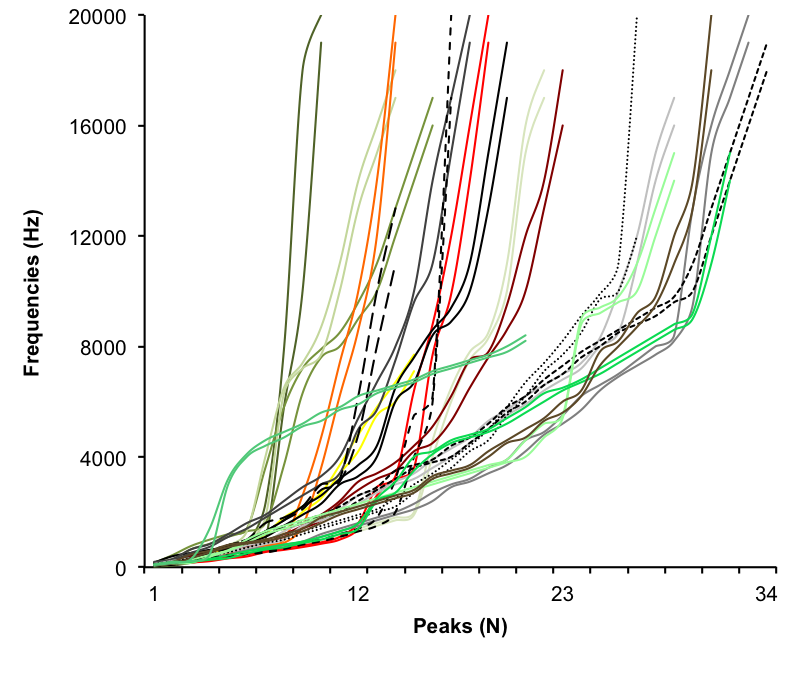
Addendum
Supplementary editing, effecting, and exporting were performed. First, track 10 was effected with an equalization curve according to the overall average peak frequency with standard error ranges (4236.87 Hz, 4392.99 Hz, and 4549.11 Hz), exporting: 11. Salsify; Scorzonera L.; Asteraceae: Cichorieae (11x Pan 90% Left, -16.8 dB; 11y Pan 90% Right, -12.0 dB; Overall -13.4 dB, 12-minutes, 254 MB). Second, track 10 was effected with equalization curves according to overall average and recurrent peak frequencies (N = 38 peaks), exporting: 12. Ragwort; Senecio L.; Asteraceae: Senecioneae (12x Pan 90% Left, -12.0 dB; Overall -11.6 dB, 12y Pan 90% Right, -12.6 dB; 12-minutes, 254 MB). Future equalization curves could be created according to interactions of overall peak frequencies, shown as line crossings in Figure 1. Future permutations of mixed N.N tracks or N.Nx and N.Ny duplicate tracks may further possibilities of audio exportations.Figure 2. Images were designed with 144 photographs comprising 12 photos each of all 12 track title genera native to the Große Mühl region. Photographs were searched and sampled from Google Images (Google 2019) and imported, edited, layered, and exported with Adobe Photoshop 21.0.1 (Adobe 2019). Compositae images show soundscape features: amplification, filtration, compression, reproduction, and beautification.
